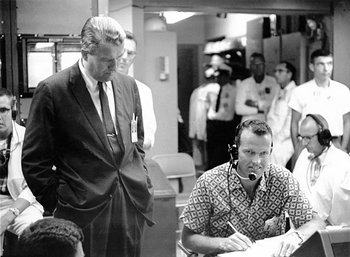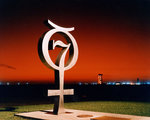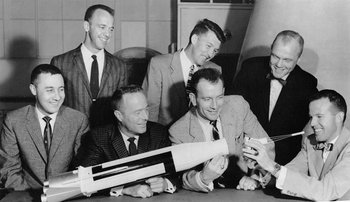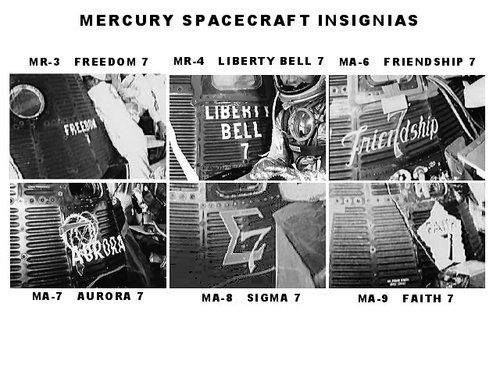Project Mercury
|
|
| McDonnell Mercury capsule | ||
|---|---|---|
| Missing image Mercury_Capsule2.jpg The Mercury capsule | ||
| Description | ||
| Role: | Suborbital and orbital spaceflight | |
| Crew: | one, pilot | |
| Dimensions | ||
| Height: | 11.5 ft | 3.51 m |
| Diameter: | 6.2 ft | 1.89 m |
| Volume: | 60 ft3 | 1.7 m3 |
| Weights (MA-6) | ||
| Launch: | 4,265 lb | 1,935 kg |
| Orbit: | 2,986 lb | 1,354 kg |
| Post Retro: | 2,815 lb | 1,277 kg |
| Reentry: | 2,698 lb | 1,224 kg |
| Landing: | 2,421 lb | 1,098 kg |
| Rocket engines | ||
| Retros (solid fuel) x 3: | 1,000 lbf ea | 4.5 kN |
| Posigrade (solid fuel) x 3: | 400 lbf ea | 1.8 kN |
| RCS high (H2O2) x 6: | 25 lbf ea | 108 N |
| RCS low (H2O2) x 6: | 12 lbf ea | 49 N |
| Performance | ||
| Endurance: | 34 hours | 22 orbits |
| Apogee: | 175 miles | 282 km |
| Perigee: | 100 miles | 160 km |
| Retro delta v: | 300 mph | 483 km/h |
| Mercury capsule diagram | ||
 Mercury capsule Diagram (NASA) | ||
| McDonnell Mercury capsule | ||
Project Mercury was the United States's first successful manned spaceflight program. It ran from 1959 through 1963 with the goal of putting a man in orbit around the Earth. Early planning and research was carried out by NACA, while the program was officially carried out by the newly created NASA. The name Mercury comes from the Roman god (it is also the name of the innermost planet of the solar system).
The Mercury program cost $1.5 billion in 1994 dollars. See NASA Budget.
Spacecraft
Mercury spacecraft (also called a capsule or space capsule) were very small one-man vehicles; it was said that the Mercury spacecraft were not ridden, they were worn. Only 1.7 cubic meters in volume, the Mercury capsule was barely big enough to include its pilot. Inside were 120 controls: 55 electrical switches, 30 fuses and 35 mechanical levers. The spacecraft was designed by Max Faget and NASA's Space Task Group.
During the launch phase of the mission, the Mercury spacecraft and astronaut were protected from launch vehicle failures by the Launch Escape System. The LES consisted of a solid fuel, 52,000 lbf (231 kN) thrust rocket mounted on a tower above the spacecraft. In the event of a launch abort, the LES fired for 1 second, pulling the Mercury spacecraft away from a defective launch vehicle. The spacecraft would then descend on its parachute recovery system. After booster engine cutoff (BECO), the LES was no longer needed and was separated from the spacecraft by a solid fuel, 800 lbf (3.6 kN) thrust jettison rocket, that fired for 1.5 seconds.
To separate the Mercury spacecraft from the launch vehicle, the spacecraft fired three small solid fuel, 400 lbf (1.8 kN) thrust rockets for 1 second. These rockets are called the Posigrade rockets.
The spacecraft had only attitude control thrusters. After orbit insertion and before retrofire they could not change their orbit. The spacecraft had three sets of control jets for each axis (yaw, pitch and roll), supplied from two separate fuel tanks. An automatic set of high and low powered jets and a set of manual jets, fueled from either the automatic tank or the manual tank. The pilot could use any one of the three thruster systems and fuel them from either of the two fuel tanks to provide spacecraft attitude control.
The Mercury spacecraft were designed to be totally controllable from the ground in the event that the space environment impaired the pilot's ability to function.
The spacecraft had three solid fuel, 1000 lbf (4.5 kN) thrust retrorockets that fired for 10 seconds each. One was sufficient to return the spacecraft to earth if the other two failed. The first retro was fired, five seconds later the second was fired (while the first was still firing). Five seconds after that, the third retro fires (while the second retro is still firing). This is called ripple firing.
There was a small metal flap at the nose of the spacecraft called the "spoiler". If the spacecraft started to reenter nose first (another stable reentry attitude for the capsule), airflow over the "spoiler" would flip the spacecraft around to the proper, heatshield first reentry attitude.
Suborbital Mercury capsules encountered lower reentry temperatures and used a beryllium heat-sink heat shields. Orbital missions encountered much higher atmospheric friction and temperatures during reentry and used ablative shields.
NASA ordered 20 production spacecraft, numbered 1 through 20, from McDonnell Aircraft Company, St. Louis, Missouri. Five of the twenty spacecraft were not flown. They were, Spacecraft #10, 12, 15, 17, and 19. Two unmanned spacecraft were destroyed during flights. They were Spacecraft #3 and #4. Spacecraft #11 sank and was recovered from the bottom of the Atlantic Ocean after 38 years. Some spacecraft were modified after initial production (refurbished after launch abort, modified for longer missions, etc) and received a letter designation after their number, examples 2B, 15B. Some spacecraft were modified twice, example, spacecraft 15 became 15A and then 15B.
A number of boilerplate spacecraft (mockup/prototype/replica spacecraft, made from non-flight materials or lacking production spacecraft systems and/or hardware) were also made by NASA and McDonnell Aircraft and used in numerous tests, including launches.
Boosters
Mercury_Atlas_9.jpg
The Mercury program used three boosters: Little Joe, Redstone, and Atlas. Little Joe was used to test the escape tower and abort procedures. Redstone was used for suborbital flights, and Atlas for orbital ones. Starting in October, 1958, Jupiter missiles were also considered as suborbital launch vehicles for the Mercury program, but were cut from the program in July, 1959 due to budget constraints. The Atlas boosters required extra strengthening in order to handle the increased weight of the Mercury capsules beyond that of the nuclear warheads they were designed to carry. Little Joe was a solid-propellant booster designed specially for the Mercury program.
The Titan missile was also considered for use for later Mercury missions, however the Mercury program was terminated before these missions were flown. The Titan was used for the Gemini program which followed Mercury
Astronauts
The first Americans to venture into space were drawn from a group of 110 military pilots chosen for their flight test experience and because they met certain physical requirements. Seven of those 110 became astronauts in April 1959. Six of the seven flew Mercury missions (Deke Slayton was removed from flight status due to a heart condition). Beginning with Alan Shepard's Freedom 7 flight, the astronauts named their own spacecraft, and all added 7 to the name to acknowledge the teamwork of their fellow astronauts
Mercury had seven prime astronauts, all former military test pilots, known as the Mercury 7. NASA announced the selection of these astronauts on April 9, 1959.
- M. Scott Carpenter (1925-)
- L. Gordon Cooper, Jr. (1927-2004)
- John H. Glenn. Jr. (1921-)
(first American to orbit the earth) - Virgil I. "Gus" Grissom (1926-1967)
- Walter M. Schirra, Jr. (1923-)
- Alan B. Shepard, Jr. (1923-1998)
(first American in space) - Donald K. "Deke" Slayton (1924-1993)
Flights
The program included 20 robotic launches. Not all of these were intended to reach space and not all were successful in completing their objectives. The fifth flight in 1959 launched a monkey named Sam (a rhesus monkey named after the Air Force School of Aviation Medicine) into space. Other non-human space-farers were Miss Sam (a rhesus monkey), Ham and Enos, both chimpanzees.
The Mercury program used the following launch vehicles:
- Little Joe - Suborbital, robotic, and primate flights. Launch escape system tests
- Redstone - Suborbital robotic, primate and piloted orbital flights.
- Atlas - Suborbital robotic, robotic, primate, and piloted orbital flights.
Robotic
- Mercury-Jupiter - Cancelled in July, 1959 - Proposed suborbital launch vehicle for Mercury. Not flown.
- Little Joe 1 - August 21, 1959 - test of launch escape system during flight
- Big Joe 1 - September 9, 1959 - test of heat shield and Atlas / spacecraft interface
- Little Joe 6 - October 4, 1959 - Test of capsule aerodynamics and integrity
- Little Joe 1A - November 4, 1959 - test of launch escape system during flight
- Little Joe 2 - December 4, 1959 - carried Sam the monkey to 85 kilometres in altitude
- Little Joe 1B - January 21, 1960 - carried Miss Sam the monkey to 9.3 statute miles (15 kilometres) in altitude
- Beach Abort - May 9, 1960 - test of the Off-The-Pad abort system
- Mercury-Atlas 1 - July 29, 1960 - first flight of Mercury spacecraft and Atlas Booster
- Little Joe 5 - November 8, 960 - first flight of a production Mercury spacecraft
- Mercury-Redstone 1 - November 21, 1960 - Launched 4 inches (100 mm). Settled back on pad due to electrical malfunction
- Mercury-Redstone 1A - December 19, 1960 - first flight of Mercury spacecraft and Redstone booster
- Mercury-Redstone 2 - January 31, 1961 - carried Ham the Chimpanzee on suborbital flight
- Mercury-Atlas 2 - February 21, 1961 - test of Mercury spacecraft and Atlas Booster
- Little Joe 5A - March 18, 1961 - test of the launch escape system during the most severe conditions of a launch
- Mercury-Redstone BD - March 24, 1961 - Redstone Booster Development - test flight
- Mercury-Atlas 3 - April 25, 1961 - test of Mercury spacecraft and Atlas Booster
- Little Joe 5B - April 28, 1961 - test of the launch escape system during the most severe conditions of a launch
- Mercury-Atlas 4 - September 13, 1961 - test of Mercury spacecraft and Atlas Booster
- Mercury-Scout 1 - November 1, 1961 - test of Mercury tracking network
- Mercury-Atlas 5 - November 29, 1961 - carried Enos the Chimpanzee on a two orbit flight
Primate flights
- Little Joe 2 - December 4, 1959 - carried Sam the monkey to 85 kilometres in altitude
- Little Joe 1B - January 21, 1960 - carried Miss Sam the monkey to 9.3 statute miles (15 kilometres) in altitude
- Mercury-Redstone 2 - January 31, 1961 - carried Ham the Chimpanzee on suborbital flight
- Mercury-Atlas 5 - November 29, 1961 - carried Enos the Chimpanzee on a two orbit flight
Piloted
Suborbital
- Mercury-Redstone 3 (Freedom 7) - 5 May 1961 - Alan Shepard
- Mercury-Redstone 4 (Liberty Bell 7) - 21 July 1961 - Gus Grissom
Orbital
- Mercury-Atlas 6 (Friendship 7) - 20 February 1962 - John Glenn
- Mercury-Atlas 7 (Aurora 7) - 24 May 1962 - Scott Carpenter (replaced Deke Slayton)
- Mercury-Atlas 8 (Sigma 7) - 3 October 1962 - Wally Schirra
- Mercury-Atlas 9 (Faith 7) - 15 May 1963 - Gordon Cooper
- Mercury-Atlas 10 (Freedom 7-II) - October 1963 - Cancelled June 13, 1963

Mercury_Control.jpg
Piloted Mercury launches
Mercury Flight insignias
Flight patches are available to the public that purport to be patches from various Mercury missions. In reality, these patches were designed long after the Mercury program ended by private entrepreneurs. When genuine flight patches were created by crews in the Gemini program, this caused a public demand for Mercury flight patches, which was filled by these private entrepreneurs. The only patches the Mercury astronauts wore were the NASA logo and a name tag. Each manned Mercury spacecraft, however, was decorated with a flight insignia. These are the genuine Mercury flight insignias. They were approved by the Mercury astronauts and painted on their spacecraft. Each flight insignia is illustrated in the photo above.
Follow-on programs
Template:US manned space programs
Miscellaneous
The Mercury astronauts trained, in part, at Langley Air Force Base in Hampton, Virginia. Several bridges throughout the city bear the name of the Mercury astronauts, and the main route in the city is named Mercury Boulevard, honoring the Mercury program.
The names of five of the Mercury astronauts are also commemorated in the popular 1960s TV show Thunderbirds. In the series, Jeff Tracy, the founder of the fictional International Rescue organisation, is a millionaire ex-astronaut who has named his five sons -- Scott, Virgil, Alan, John and Gordon -- after the real-life Mercury astronauts.
Further reading
- Gene Kranz, Failure is Not an Option. Factual, from the standpoint of a chief flight controller during the Mercury, Gemini, and Apollo space programs. ISBN 0743200799
- Tom Wolfe, The Right Stuff. Sentimental, from the astronaut viewpoint, not meant to be taken as a strict history, but fascinating anyway.
- Schirra, Grissom, Glenn, Slayton, Shepherd, Carpenter, Cooper, We Seven. (ISBN B00005X54G); Simon & Schuster - 1962. Factual; a collection of articles written by the seven Mercury astronauts describing events from their points of view.
- James M. Grimwood, This New Ocean: A History of Project Mercury (http://www.hq.nasa.gov/office/pao/History/SP-4201/cover.htm)
- James M. Grimwood, Project Mercury - A Chronology (http://history.nasa.gov/SP-4001/cover.htm)
- Mae Mills Link, Space Medicine In Project Mercury (http://www.hq.nasa.gov/office/pao/History/SP-4003/cover.htm)
- Results of the first US manned orbital space flight - Feb 20, 1962 (Friendship 7) NASA report - (PDF format) (http://ntrs.nasa.gov/archive/nasa/casi.ntrs.nasa.gov/19930074071_1993074071.pdf)
- Results of the second u.s. manned orbital space flight, May 24, 1962 (Aurora 7) NASA report - (PDF format) (http://ntrs.nasa.gov/archive/nasa/casi.ntrs.nasa.gov/19620004691_1962004691.pdf)
- This New Ocean: A History of Project Mercury - NASA report (PDF format) (http://ntrs.nasa.gov/archive/nasa/casi.ntrs.nasa.gov/19990026158_1999028570.pdf)
- Chronology of Project Mercury - NASA report (PDF format) (http://ntrs.nasa.gov/archive/nasa/casi.ntrs.nasa.gov/19630011968_1963011968.pdf)
See also
External links
- The Mercury Project (Kennedy Space Center) (http://www-pao.ksc.nasa.gov/kscpao/history/mercury/mercury.htm)
- Project Mercury A Chronology (Prepared by James M. Grimwood) (http://history.nasa.gov/SP-4001/contents.htm)
- Space Medicine In Project Mercury By Mae Mills Link (http://history.nasa.gov/SP-4003/cover.htm)
- Project Mercury Drawings and Technical Diagrams (http://www.hq.nasa.gov/office/pao/History/diagrams/mercury.html)
- Technical Diagrams and Drawings (http://www.hq.nasa.gov/office/pao/History/diagrams/diagrams.htm)
- Mercury-Atlas Diagrams (http://www.geocities.com/atlas_missile/mercury.htm)
- Project Mercury Simulator for the PC (Orbiter) (http://projectmercury5.moonport.org)
- Project Mercury Simulator for the Mac (http://youarego.com)
- The Mercury Redstone Project (PDF) December 1964 (http://ntrs.nasa.gov/archive/nasa/casi.ntrs.nasa.gov/19670028606_1967028606.pdf)
- Project Mercury familiarization manual (PDF) November 1961 (http://ntrs.nasa.gov/archive/nasa/casi.ntrs.nasa.gov/19740076527_1974076527.pdf)
- Various PDFs of historical Mercury documents including familiarization manuals. (http://www.ibiblio.org/mscorbit/document.html)it:Programma Mercury
de:Mercury-Programm es:Proyecto Mercury fr:Programme Mercury he:תוכנית מרקורי lb:Mercury Programm nl:Mercury pt:Projeto Mercury ja:マーキュリー計画 pl:Program Mercury




